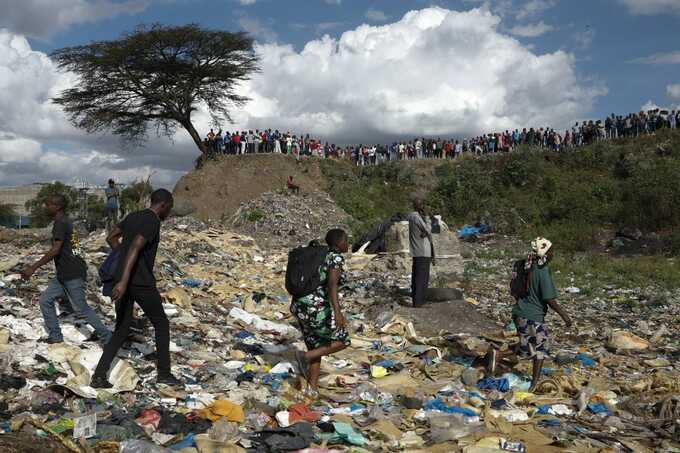Kenyan police discover additional female body parts at Nairobi garbage dump

Police have been scouring site in Mukuru since mutilated corpses of at least six women were found on Friday
Kenyan police said that they had found more bags filled with dismembered female body parts on Saturday, the latest macabre discovery at a rubbish dump that has horrified and angered the country.
Detectives have been scouring the site in the Nairobi slum of Mukuru since the mutilated corpses of at least six women were found on Friday in sacks floating in a sea of garbage.
The Directorate of Criminal Investigations (DCI) on Saturday said that another five bags had been retrieved from the abandoned quarry, three of them containing female body parts, including severed legs and two torsos.
“We want to assure the public that our investigations will be thorough and shall cover a wide range of areas, including but not limited to the possible activities of cultists and serial killings,” it said in a statement.
Kenya was left reeling last year by the discovery of mass graves in a forest near the Indian Ocean coast containing the bodies of hundreds of followers of a doomsday sect, one of the world’s worst cult-related massacres.
The country’s law enforcement services are also under scrutiny after dozens of people were killed during anti-government demonstrations last month, with rights groups accusing officers of using excessive force and of abducting protesters.
Police on Friday had reported finding bodies of at least six women in Mukuru, while the state-funded police watchdog said nine bodies had been found, seven of them women.
Tensions have been running high at the Mukuru site, with local media reports that police had fired into the air to try to disperse an angry crowd.
The DCI said a team of detectives and forensic experts “were impeded by agitated members of the public from accessing the scene”.
The Independent Police Oversight Authority (Ipoa) on Friday had said that it was investigating whether there was any police involvement in the gruesome saga.
“The bodies, wrapped in bags and secured by nylon ropes, had visible marks of torture and mutilation,” it said, noting that the dumpsite was less than 100 metres from a police station.
The Ipoa also said it was looking into claims of abductions of demonstrators who went missing after the deadly anti-government protests, but did not link those missing to the dumped bodies.
Some people on social media have described them as victims of femicide.
The Kenyan president, William Ruto, on Saturday said there was “no justification” for any Kenyan to lose their life.
“We are a democratic country guided by the rule of law. Those involved in mysterious killings in Nairobi and any other part of the country will be held to account,” he said on X.
Kenya’s feared police force is often accused of extrajudicial killings and other rights abuses, but convictions are rare.
A coalition of civil society and rights groups said the Mukuru discoveries came amid a “troubling surge” in cases of mysterious disappearances and abductions, particularly after the anti-tax protests.
“It represents a grave violation of human rights and raises serious concerns about the rule of law and security in our country,” the coalition said.
National police chief Japhet Koome resigned on Friday after being the target of much public anger over the protest deaths.
Ruto is scrambling to contain the worst crisis of his rule over the deeply unpopular plans for tax hikes, which he has now scrapped.
Crowds that gathered at the dumpsite on Friday chanted “Ruto must go”, the slogan of Gen-Z Kenyans leading the demonstrations that have now morphed into a wider campaign against the president, corruption and alleged police brutality.
On Monday, doomsday cult leader Paul Nthenge Mackenzie went on trial along with 94 co-defendants over the deaths of more than 400 followers he is accused of inciting to starve themselves to death to meet Jesus.
He and his co-accused also face charges of murder, manslaughter and child cruelty in separate cases over what has been dubbed the “Shakahola forest massacre”.
Read more similar news:
Comments:
comments powered by Disqus

































